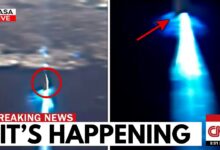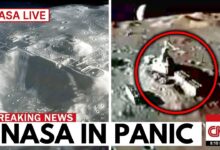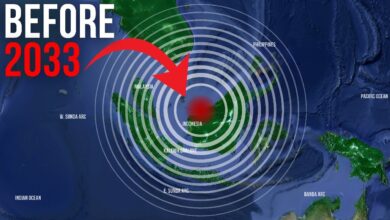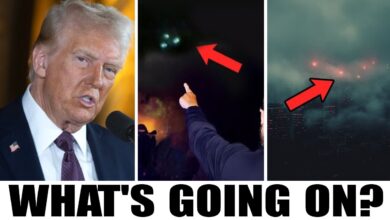Voyager 2 Just Turned Back and CONFIRMS What WE ALL FEARED

**”Voyager 2: The Final Signal When Leaving the Solar System That Silenced the Scientific World”**
In 1977, Voyager 2 was launched by NASA with a great mission: to explore planets outside the Solar System and then enter interstellar space. On that ship was a golden disc – carrying a message from humanity to civilizations outside of Earth, if anyone in that far away place ever caught it.
Nearly 50 years have passed, Voyager 2 has traveled tens of billions of kilometers, left the protective “bubble” of the Sun – also known as the heliosphere – and officially entered interstellar space. But the strangest thing was not the journey itself, but the **last signal it sent back before it left**.
The moment the spacecraft left the edge of the Solar System, scientists received a signal that was extremely unusual. It was unlike any data Voyager 2 had ever sent back before. It wasn’t cosmic background noise. It wasn’t radiation from distant stars. It was a **structured**, repeating pattern—as if it had been arranged on purpose.
At first, engineers thought Voyager 2 might have malfunctioned—some kind of technical glitch that had caused the data to become distorted. But after months of analysis, they ruled that out entirely. The signal wasn’t a bug. It had a pattern. It had a rhythm. And most strikingly: **it stopped abruptly**, just after Voyager 2 crossed the heliosphere.
Why did the strange signal appear just as the spacecraft was leaving the edge of the Solar System? What was waiting outside? And who – or what – sent that silent “greeting”?
Many theories began to emerge. Some suggested that the signal was the response of some kind of alien intelligence – a “sensor net” surrounding the Solar System, tasked with recording and monitoring everything that came and went. Some researchers went further, saying that the signal could be a **warning** – a whisper from the void: “You have crossed the line.”
The scariest thing: **NASA did not release the details of the signal.** All related documents were kept secret. They only admitted that, “it was something never seen before.”
The biggest question remained: What was the signal? Who – or what – was on the other side of interstellar space?
And what if one day, Voyager 2 not only sends back a signal… but also receives a **response**?
That event changed the course of human destiny — not by force, not by grand declaration, but by the simplest and most profound act of all: observation. For what instilled the deepest fear was not the sight of a giant ship appearing in the sky, or the voice echoing among the stars. It came as a whisper, from an ancient, dying machine at the edge of the universe. And in that whisper was a chillingly clear message: “We were here.”
From then on, the question was no longer, “Will we ever be contacted again?” but, “What did they see when they observed us? And what will they do next?”
The milestone was not just the mysterious signal from Voyager 2, but the sudden realization of its significance — especially for those who had considered theories about alien life vague and impractical. Scientists who had spent their lives studying comets, plasmas, and deep space were now forced to confront a completely different language: intention. The universe was no longer a passive object to be observed — it was a partner in a conversation. And the line between the two was thin and terrifying.
After Voyager 2’s sudden signal, scientists immediately turned their attention to the space between the Solar System and the nearest star systems — a region that had been assumed to be empty, silent, filled with interstellar dust and gas. But what Voyager 2 encountered shattered that assumption. Instead, that space might be an invisible structure, an established network. No longer a dead desert of space, but a place where a presence had been built, even if it had never been detected.
Scientists began to talk about a chilling possibility: perhaps the Milky Way harbored long-hidden “watchers” — and we just didn’t know where to look.
And the suspicion spread beyond astronomy. Neuroscientists, linguists, and even codebreakers were called in — not to translate a language, but to analyze what had never been said. Voyager offered not a conversation, but a gentle touch, a veil-lift. It didn’t sound like the behavior of a civilization that wanted to share its knowledge — it sounded like a watchdog, stopping its watch when it realized it had been detected.
That detail was vital. A civilization that broadcasts clear messages might be a diplomatic partner. But a civilization that quietly collects data and then disappears… might be a watchdog, an evaluator, or worse — an enforcer. They were just waiting for a threshold to be crossed.
The big question: why now? Voyager 2 has been transmitting data for decades, so what changed? Some theories suggest that the increasingly chaotic digital signals from Earth have finally crossed a threshold that is noticeable on a galactic scale. Or perhaps, among the thousands of messages, a specific mathematical sequence or signal pattern has emerged — like a key that accidentally triggers a surveillance system.
Another idea is more technical: the electromagnetic signature of civilization. As it grows, each planet emits its own “energy signature.” Earth’s rapid transition — from sporadic broadcasts to global networks, from analog to digital — may have created a signal strong enough to alert a system that has been quietly monitoring it from afar. Not a coincidence, but an alarm.
From there, an even darker hypothesis emerged: perhaps they were more than mere observers out of curiosity. Perhaps they were guardians of some interstellar rule. A civilization that surpassed a certain level of technology, emitting enough signals to be detected, might trigger a mechanism of checks, even restrictions.
The surveillance system might not be goodwill ambassadors. It might be law enforcers. And the silence was no longer indifference — it was calculation.
An unprecedented campaign was launched: data from old satellites and probes was re-encoded using advanced AI models. They were not looking for new signals, but looking back in history, looking for something that might have been overlooked. And then, strange signs began to emerge: periodic pulses of radiation, seemingly random but regular frequency disturbances, small changes in spacecraft orbits that could not be explained by existing laws of physics.
Cassini — the spacecraft that studied Saturn — detected an anomaly in the planet’s outer magnetic field, which was initially thought to be solar interference. But upon reanalysis, experts discovered that it was likely a structured electromagnetic pulse — not a signal, but rather the “aftershock” left behind by something huge and invisible after passing by.
And it wasn’t just Saturn. New Horizons, the Pluto flyby, had picked up similar anomalies. It was as if there was a subtle layer of activity, hidden beneath the surface of human perception — but always there.
Now behavioral ecologists were called in. They didn’t know astronomy, but they were good at analyzing behavior without language. And they asked a crucial question: “What happens when the observer stops observing?”
A frightening hypothesis emerged, based on the natural predator model. The apex predator often observes for a long time before it acts. When it disappears from view, it’s not a retreat — it’s the end of the observation period. And the action comes later.
If that’s true, then the silence after Voyager 2’s signal didn’t signal the end — it was the beginning. Maybe they had enough data. And the next phase… had begun.
Observatories around the world turned their telescopes, scanning regions of space that had once been considered “nonsense.” They weren’t looking for spacecraft—they were looking for phase shifts, for thermal fluctuations, for unusual gravitational distortions. They were looking for behavior, not objects. For shadows of things that didn’t shine—that warped space.
And then a second anomaly appeared—not near Voyager 2, but toward Neptune. A brief, strange oscillation in the planet’s magnetic field, unrelated to solar activity or internal fluctuations. Just a flash, but noticeable enough—it happened just days after Voyager’s last signal. And a few days after that, Mars. A small quiver in the planet’s thin ionosphere, followed by a geoshock that had nothing to do with tectonics.
None of it was big enough to cause panic. But it painted a pattern. A silent message.
They hadn’t left yet.
They are here.








